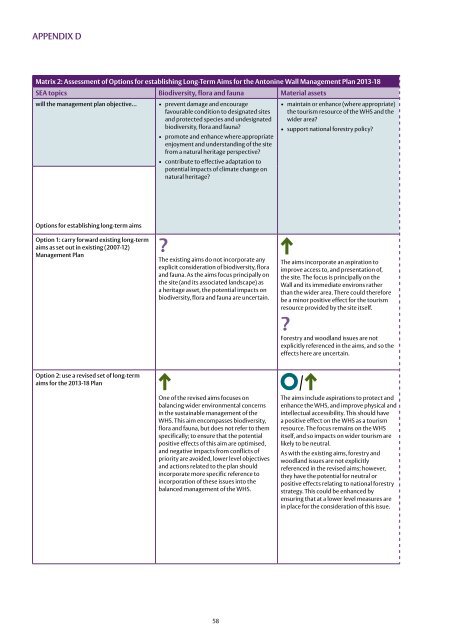The Antonine Wall Management Plan 2013-18 - Glasgow City Council
The Antonine Wall Management Plan 2013-18 - Glasgow City Council
The Antonine Wall Management Plan 2013-18 - Glasgow City Council
You also want an ePaper? Increase the reach of your titles
YUMPU automatically turns print PDFs into web optimized ePapers that Google loves.
appendix D<br />
Matrix 2: Assessment of Options for establishing Long-Term Aims for the <strong>Antonine</strong> <strong>Wall</strong> <strong>Management</strong> <strong>Plan</strong> <strong>2013</strong>-<strong>18</strong><br />
SEA topics Biodiversity, flora and fauna Material assets<br />
will the management plan objective…<br />
• prevent damage and encourage<br />
favourable condition to designated sites<br />
and protected species and undesignated<br />
biodiversity, flora and fauna?<br />
• promote and enhance where appropriate<br />
enjoyment and understanding of the site<br />
from a natural heritage perspective?<br />
• contribute to effective adaptation to<br />
potential impacts of climate change on<br />
natural heritage?<br />
• maintain or enhance (where appropriate)<br />
the tourism resource of the WHS and the<br />
wider area?<br />
• support national forestry policy?<br />
Options for establishing long-term aims<br />
Option 1: carry forward existing long-term<br />
aims as set out in existing (2007-12) ?<br />
<strong>Management</strong> <strong>Plan</strong><br />
<strong>The</strong> existing aims do not incorporate any<br />
explicit consideration of biodiversity, flora<br />
and fauna. As the aims focus principally on<br />
the site (and its associated landscape) as<br />
a heritage asset, the potential impacts on<br />
biodiversity, flora and fauna are uncertain.<br />
<strong>The</strong> aims incorporate an aspiration to<br />
improve access to, and presentation of,<br />
the site. <strong>The</strong> focus is principally on the<br />
<strong>Wall</strong> and its immediate environs rather<br />
than the wider area. <strong>The</strong>re could therefore<br />
be a minor positive effect for the tourism<br />
resource provided by the site itself.<br />
?<br />
Forestry and woodland issues are not<br />
explicitly referenced in the aims, and so the<br />
effects here are uncertain.<br />
Option 2: use a revised set of long-term<br />
aims for the <strong>2013</strong>-<strong>18</strong> <strong>Plan</strong><br />
One of the revised aims focuses on<br />
balancing wider environmental concerns<br />
in the sustainable management of the<br />
WHS. This aim encompasses biodiversity,<br />
flora and fauna, but does not refer to them<br />
specifically; to ensure that the potential<br />
positive effects of this aim are optimised,<br />
and negative impacts from conflicts of<br />
priority are avoided, lower level objectives<br />
and actions related to the plan should<br />
incorporate more specific reference to<br />
incorporation of these issues into the<br />
balanced management of the WHS.<br />
/<br />
<strong>The</strong> aims include aspirations to protect and<br />
enhance the WHS, and improve physical and<br />
intellectual accessibility. This should have<br />
a positive effect on the WHS as a tourism<br />
resource. <strong>The</strong> focus remains on the WHS<br />
itself, and so impacts on wider tourism are<br />
likely to be neutral.<br />
As with the existing aims, forestry and<br />
woodland issues are not explicitly<br />
referenced in the revised aims; however,<br />
they have the potential for neutral or<br />
positive effects relating to national forestry<br />
strategy. This could be enhanced by<br />
ensuring that at a lower level measures are<br />
in place for the consideration of this issue.<br />
58












![Elgin Cathedral Wedding Brochure [pdf, 544kb] - Historic Scotland](https://img.yumpu.com/22301571/1/190x151/elgin-cathedral-wedding-brochure-pdf-544kb-historic-scotland.jpg?quality=85)



